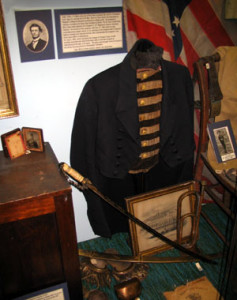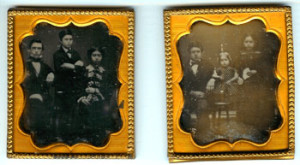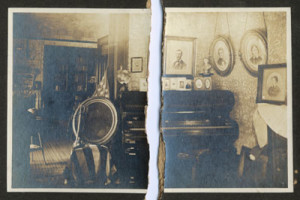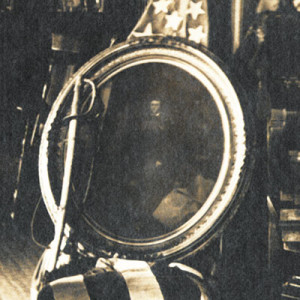Family Values: Lessons in material culture
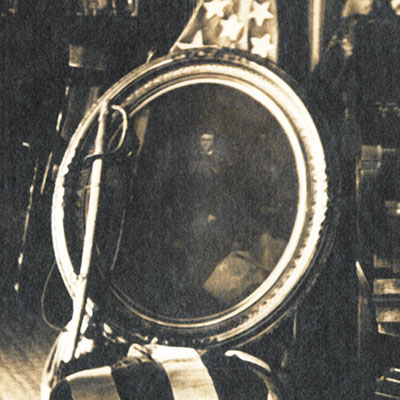
Give me the death of those
Who for their country die;
And, O! be mine like their repose,
When cold and low they lie!
In kind embrace our mother earth
Enshrines the fallen brave;
In her sweet lap, who gave them birth,
They find a tranquil grave.
A Soldier
—From John J. P. Blinn, “The Citizen Soldier,” Wabash Monthly (1860)
I.
As a research librarian for the past twenty years, I have often envied the scholar who made a serendipitous discovery in the stacks—a stash of historic letters tucked inside a book, an adventurer’s lost diary, a rare book shelved alongside the ordinary. Little did I imagine that a chain of such discoveries would occur in my own life when six months after my mother’s death I traveled from my home in New Haven, Connecticut, back to Chagrin Falls, Ohio, to spend a week with my father organizing family memorabilia.
My father—approaching his eightieth birthday—was eager to put grief behind him and start anew. Feeling blessed by the prospect of good health and new friendships, he wanted to disencumber himself of the family possessions that my mother had carefully shepherded back and forth across the country as the family trailed my father in the corporate chain of transfers. With the seventh move and the addition of my deceased grandmother’s “treasures,” my parents settled for their last twenty years in a historic residence—an enlarged country schoolhouse situated on the edge of the Cat’s Den, a small grotto that according to local legend was the haunt of wild cats. While my father looked to the future, I delved into the past.
Starting in the dining room, I stared blankly at the large gold-framed portrait of a young woman. Although I had walked past her a hundred times, I had never stopped to ask, “Who is she, the woman with knotted braids gracing her rose-tinted cheeks?” She had hung there since my grandmother’s death twenty years ago, and perhaps I had been told who she was, but I never paid any attention. “She may not have been a relative,” my father observed. “I don’t think Nancy even knew for sure.” Of course she did know, having inherited the painting from her mother, but now I would have to make that discovery on my own.
After several days of cleaning and sorting, I came across a box of my grandmother’s photographs. There I discovered a small black-and-white image of an oil portrait of a young man, posed and framed to match that of the woman hanging in our dining room. Turning it over, I found penned on the back: “Portrait Horace Blinn, over piano in L.R.” If this was Horace Blinn (1801-60)—my great-great-great-grandfather—then the woman in question surely must be his wife, but which one? He married three times. What had happened to his portrait and why had the two been separated? I tucked the black-and-white photo into the edge of the framed portrait in the dining room as an inspiration to keep searching.
With the help of books about silver, furniture, and porcelain checked out from the local public library, I tried to identify items of value and mark them for family members. Toward the end of the fifth day, I decided to empty out a kitchen cupboard, expecting to find stuff that would be easy to throw away. At the bottom of the heap was an old spiral-bound notebook. Aimlessly flipping through it, I found the unexpected: “Inventory August 22, 1977,” amended, “January 14, 1978—Helen Blinn Johnston.” Here were the clues that I needed: my mother’s notes about her mother’s furnishings, listing items room by room. Dining room: “Portrait—Dorothea Froment Blinn—HBJ’s Great-grandfather’s 3rd wife—Terre Haute—She came from New York, circa 1825; Insured for $500; Jim B. has husband over his mantle.”
So now I knew: the subjects were a couple, and the portraits a matched pair split up when my grandmother, Helen Blinn Johnston, acquired Dorothea and her brother acquired Horace. I had thought that the Blinn family migrated from Wethersfield, Connecticut, to Cincinnati, Ohio; what then was the reference to Terre Haute? I had just returned from living in Bloomington for five years, a short distance from Terre Haute, and no one had ever mentioned family connections in Indiana to me.

My father was elated at the news and, eager to rid himself of the “hideous portrait,” he emailed my mother’s cousin, who had inherited the mate. Perhaps, he suggested, it was time for the pair to be reunited.
Following the advice of a family friend, I insisted that we get the portrait appraised before deciding what do with it. My father complied, reluctantly loading the portrait into the car for a trip to a fine arts gallery in Cleveland. After taking a photograph, the appraiser returned her to us, and the painting went back on the dining room wall. It would take a few weeks to get the report.
In the meantime, I could return to the arduous task of separating the valuable from the invaluable. My mother’s annotated inventory was of great help:
- scalloped pedestal table—$5.00 at garage sale
- swivel-top square table—Grandfather Blinn’s (Amory Kinney Blinn) card table. Wethersfield, Conn. & Terre Haute
- glass plate—”Give us this day . . .” belonged to Grandmother Blinn’s family—Terre Haute probably
The week came to an end and it was time for my flight back to New Haven. Armed with copious notes, inventories, and piles of receipts, I promised to put my findings in a spreadsheet to share with my father, sisters, and brother. Congratulating myself on finishing the most difficult task, I planned to return to Chagrin Falls in late May to dispense with the family letters and photographs. In truth, I had no interest in becoming the family’s historian and left the papers until the end, rather dreading the thankless task.
Meanwhile back in New Haven, I began looking for a suitable home for the portrait of Dorothea Froment Blinn. I first contacted the Vigo County Historical Society in Terre Haute about the painting. The director’s response was enthusiastic: indeed, they would be very interested. The director told me that Dorothea was the wife of a pioneer settler, Horace Blinn, and the mother of a Civil War hero—Captain John J. P. Blinn—whose uniform, sword, and other military memorabilia were on display at the museum. The historical society also had a family scrapbook about him and several autograph letters, including one he wrote to his mother in September 1862 that, according to the director, always brought tears to her eyes. “On the eve of a great battle,” it begins, “I have sat down upon the ground, and with my saddle for a table, to write a few words to the loved ones at home.” What makes this letter especially poignant is that John survived this battle, Antietam, only to be mortally wounded at Gettysburg the following July. Dorothea, the director told me, would travel from Terre Haute to the battlefield hospital in Gettysburg to nurse him, only to arrive a few days before he died on July 14, 1863. He was only twenty-two years old, an extraordinary young man.
I agreed to keep in touch while the family awaited the appraisal of the portrait. It was unfortunate, I thought, that my mother never knew about Captain John Blinn. She would have loved that letter from the battlefield in Maryland and, of course, would have enjoyed sharing it with me. I remembered the proud moment in sixth grade when I won a school competition to recite the Gettysburg Address at the annual Memorial Day ceremony at the cemetery in Chagrin Falls. I recall so clearly standing in our driveway at the crest of the hill and practicing with my mother who patiently coached me from the “audience” in our backyard. What if we had known that one of our kin had given, in Lincoln’s immortal words, his “last full measure of devotion?”
As I widened my search for information about my newly found uncle, my father called to say that the gallery had assigned the portrait an insurance value of ten thousand dollars. “Can you believe it?” he asked. Actually, yes, I could. I had seen an episode of Antiques Roadshow when a young girl brought an early American portrait her mother had rescued from “the dump.” Unsigned, without provenance, in need of repair and without a frame, it was appraised at an auction value of $2,000 – $3,000. And now, unbeknownst to the appraiser, our portrait was connected to a man who had given his life to preserve the union.
I uncovered more information by searching “Blinn” at the Vigo County Historical Society’s Website where the young captain was featured in several profiles. I found a signed photograph of him in his military uniform at the Indiana State Library’s Website, Civil War Soldier Photograph Exhibit, where he was mislabeled as “Blim.” I read other accounts of Blinn and located an early biographical sketch about his father, Horace Blinn, transcribed as part of the Vigo County Indiana Biographies Project. Later, I would find among our family papers two typed transcripts of this extract—one, annotated with corrections by my great-grandfather and the other, written by his brother, who added a couple of paragraphs about Horace based on family stories.
As my knowledge about the family’s past grew, I emailed a few relatives with news of my findings, but no one really shared my enthusiasm. I heard back only from two of my mother’s cousins. They felt it was important to keep the portrait of Dorothea in the family for the benefit of future generations and they wanted to make us an offer for the painting: how much would we be asking? “She is not for sale,” I thought. She belongs in Indiana, reunited with her son, John, the Civil War patriot who grew up in Terre Haute, began his military career at Wabash College in Crawfordsville, and was among the first soldiers from his native city to volunteer for service, soon after the fall of Fort Sumter in April 1861.
II.
I finally finished the spreadsheet describing the more than two hundred household items my mother had collected. The immediate family laid claim to their favorites—the Victorian bedroom set, the Quimper china, the coin silver spoons, the pendulum clocks. We agreed the family would keep those things—chipped, tarnished, and scarred though they are—that had been passed down through multiple generations. The rest would be sold at the estate sale.
As planned, I returned to Ohio in late May, white gloves and husband in tow, with only a few days to organize the family letters and photographs. I looked forward to finishing the task quickly. However, it would soon become obvious that my real work had only begun: tucked among dozens of unidentified daguerreotypes and scores of letters, I found firsthand evidence of the soldier himself.
Wrapped carefully in a handkerchief, lying face to face, were two daguerreotype group portraits of John J. P. Blinn and his siblings, three children in each one, their images partially obscured by deterioration. A scrap of paper with their names fell out: Amory, the eldest son, and the only surviving child of Horace’s second wife, sits by Horace Jr., arms crossed, in the middle, and Charlotte to the right. In the companion photo, John, a young adolescent, is next to Sarah, a toddler, who sits like a china doll atop the stool, with Julia to the far right.
Among the scores of letters—far too many to sort through—a small booklet with a dark navy cover and gold lettering stood out:
GREGORY’S EXPRESS
POCKET LETTER BOOK,
DESIGNED
TO FACILITATE CORRESPONDENCE BETWEEN CITIES AND
TOWNS, AND THE MINING DISTRICTS IN CALIFORNIA,
AND ALL PARTS OF THE UNITED STATES.
It was a letter from the children’s father, Horace, written on April 16, 1851, to Charlotte while prospecting for gold with his son Amory in California—another piece of my family’s history that was unknown to me. My mother had started to transcribe it a few years before her death, but stopped about half-way through. “It is a kind of Lottery business to get anything handsome,” Horace writes from Owsley’s Bar on the Yuba River. “The great majority do not realize a Fortune. It is hard work to get Gold here even in small amounts—”; Still, he continues: “We think we can make more here than we can at home— Indeed we ought—for the Miner’s Life is a miserable one—If it’s not our fortune to strike any Rich Diggins—we will try to make the poor ones afford enough to take us Home.” So John’s father, who was the son of a sea captain born on Independence Day, 1776, in Wethersfield, Connecticut, had not only pioneered to the West in 1825, settling in Terre Haute, but also on the eve of his fiftieth birthday had traveled overland to California.
Rifling through the last plastic bin of papers as the second day drew to a close, I came upon a handful of letters beautifully preserved, written in a flowing script, by John J. P. Blinn himself. Here, at last, among the miscellaneous accumulation of the family’s past, I struck gold. There were ten letters in all, written to his younger sister, Julia, and to a family friend, Charles Hosford, from various encampments in Virginia and Maryland in 1861 and 1862. My husband set about reading them, finding John’s elegant hand easy to decipher and his thoughts remarkably sensitive.
As I sorted through the papers and photos, he would read me a choice passage. John is encouraging his younger sister to get a “liberal education.” And, in one poignant and intriguing passage, he tells Charles that he especially cherishes his “warm-heartedness and true friendship” because Charles was there with John’s father, “when the unfortunate accident occurred which ended his life.” What was this “unfortunate accident” that took Horace’s life? In other letters, John describes various battles, telling his sister how he is sickened at heart after his regiment’s losses at Antietam. Like a good many officers in the Civil War, he complains about the “system” for promotion that often rewarded soldiers for their political connections rather than their accomplishments in the field. “Rank is nothing in this service, and is only desirable for its pay,” he writes Julia. “It cannot be respected as long as so many incompetent officers occupy prominent positions.”
Impressed with John’s candor and eloquence, my husband and I agreed that these invaluable papers and photographs should accompany us back to New Haven. I would delay any decisions about where or how to disperse them until I had given everything more careful consideration.
Had I continued as associate dean of libraries at Indiana University, I never would have had the time to discover John J. P. Blinn. Instead, I would have taken a couple of days off to attend my mother’s memorial service, claimed a few family heirlooms without knowing their provenance, and returned to work, never giving a second thought to the fate of family letters. I was accustomed to keeping my professional and personal lives separate. At work, I was concerned with preserving resources for future generations of scholars; at home, it never occurred to me that I might advise my mother about the proper care and dispensation of family papers. While evaluating the database, Archives USA, for the library, I never thought of searching it for collections relating to my own family. When I announced the acquisition of an electronic collection of American Civil War letters and diaries, I never imagined that I would later use it to learn about my family’s past.
III.
Almost a year has gone by since my original discoveries. My father has remarried and is preparing to move into a condominium in the village. The house at the Cat’s Den is empty and on the market—its contents either distributed among family members or sold.
Meanwhile, I am reconstructing my family’s history. I have transcribed more than two dozen of John’s letters gathered from six repositories nationwide; read his essays in the Wabash Monthly, at the Robert T. Ramsay, Jr. Archival Center of Wabash College; obtained his compiled military service file and pension records; examined his scrapbook and military affects at the Vigo County Historical Society; located the correspondence of fellow soldiers in the Fourteenth Regiment; identified relevant citations in the U.S. War Department’s massive War of the Rebellion: A Compilation of the Official Records of the Union and Confederate Armies; and read scores of letters at the Cincinnati Historical Society.
I have learned that it was my great-grandfather and his brother who donated John’s military affects, which eventually found their way to the Vigo County Historical Society from the G.A.R. Morton Relief Corps No. 11 in Terre Haute. My grand-aunt gave them his scrapbook, letters, epaulettes, and lieutenant’s bars. Thanks to a gift from the estate of my great-grand-uncle, Charles Amory Blinn, given by his daughter in 1955, the Cincinnati Historical Society Library received more than twenty-seven hundred letters, constituting “The Blinn Papers,” dating from 1787 to 1948. The curator’s preface to the inventory advises, “The Blinn Papers have a limited value. Most of the correspondence concerns strictly personal matters with only occasional reference to public life and activity,” noting that “all letters and items written by prominent persons have been extracted and placed in the Society’s manuscript file.”
Among the miscellaneous papers, the society’s inventory lists Horace Blinn’s diary, dutifully kept during his perilous five-month expedition from Terre Haute to the California gold fields in 1850, offering context and substance for the 1851 letter book my mother had kept. On a scrap of paper so trifling that I am amazed it survived, Horace scribbled the addresses of his relatives in Manhattan; Williamsburgh (Brooklyn); New Britain, Connecticut; and Chester and Cleveland, Ohio—giving me new clues about when and where the family dispersed in the mid-1800s. Later, I would use historic New York City directories to find where John’s mother grew up.
At the society, I also located a half dozen more of John’s letters, including one written to Amory on November 16, 1860, describing the circumstances of their father’s death. “With a sad heart,” John explains that Horace had been on a turkey-hunting expedition in Illinois with four friends. “Father was standing up in the wagon drawing the charges of small shot from his gun and reloading with larger,” John writes, “when it is supposed that the wagon’s crossing some rough place caused him to stagger and strike his gun against the bead causing it to explode. A charge of buck shot passed through his brain killing him almost instantly.”
Within a few years, Dorothea, the unfortunate widow, would have to write Amory “with a hand bleeding to the very core” about John’s death. Vividly describing her arduous journey to Gettysburg—made “almost impossible” because the “Rebels had destroyed the rails & bridges”—she recounts her great difficulty in finding John once she arrived, his jubilation upon seeing her, his progressive lapses into a state of delirium, and his final blessings to friends and family.

When I returned to New Haven, I called my cousin, whom I knew shared my interest in family history. “Oh,” he replied, “Yes, Captain Blinn. I know about him.” In 1968 when Dean attained the rank of Eagle Scout & Order of the Arrow, our grandmother had given him a gold eagle that once belonged to the young officer. Her inscription reads, “This emblem was found among the gear of Captain John Blinn of Terre Haute, Indiana who died of wounds at the Battle of Gettysburg. He was your great, great, great uncle. May it ever remind you of your fine American Heritage. Helen Blinn Johnston.”
I now realized what I had denied before, that my mother must have also known about Captain Blinn. Why neither she nor my grandmother nor my grand-aunt ever told me about him, I will never know. I would question my own faulty memory—perhaps I did not pay attention—but none of my siblings or my father recollects ever having heard about him.
It has taken me months to be able to interpret the letters and artifacts that I brought to New Haven from Chagrin Falls. However, now when I look at the broken photograph of the interior of a heavily furnished Victorian home, I have concluded that it must be John’s sister, Charlotte’s living room. Horace and Dorothea hang on the wall to the right—my grandmother replaced their pictures with mirrors, retaining the oval gilded frames, one of which I now have. Amory’s portrait is above the piano and Julia’s is to the far right. And to the left, there is a flag-covered shrine Charlotte kept in tribute to her lost brother.
Among the newspaper clippings preserved at the Vigo County Historical Society, I copied an interview by Ruth Agnes Abeling that appeared in the Terre Haute Post around 1920, in which Charlotte explains her dedication to John’s memory. “You see,” she says, “I never married and I have no family for which to think of the future, so I live in the past.” Abeling explains, “And to her the past is her brave brother, Captain John Blinn, from the time he was a newsboy, carrying the ‘Prairie City’ to the day he was buried in Woodlawn cemetery after his death at the field hospital at Gettysburg, Pa.”
During this interview, Charlotte recalls the vibrant young man inside the uniform: “Everybody loved John,” she remembers, “and oh, the parties they gave when he came home from Wabash college! He was such a handsome boy and how he could dance!” Turning to an oil painting on the wall, she says proudly, “That is his picture.” According to the reporter, Charlotte’s eyes sparkle as she gestures toward it. “It was painted,” she says, “from just a few sittings he had while here a few days awaiting replies for orders he was carrying for General Lew Wallace—just a boy of 21 he was, but with the keen eyes and determined mouth of men of many more years.”
The portrait was a gift from John to his mother—a surprise birthday present. I had read about it in a letter at the Cincinnati Historical Society. As one cousin wrote another, his mother “knew nothing of it until she opened the Parlor door & found it hanging before her.” In the photograph that remains, propped up against the flag next to the sword, stands the oval framed picture that I now know to be John. Who painted it, I wonder, and where has it gone? Could it possibly have been an early work of James Farrington Gookins, a close Terre Haute friend and fellow college classmate, who joined the Eleventh Indiana Zouaves under Colonel Lew Wallace, but soon became a correspondent artist for Harper’s Weekly, sketching Indiana Civil War soldiers among others? Was it the portrait given by my great-grandfather and his brother along with John’s military equipment to the G.A.R. post all those years ago? Did it suffer the fate of other relics left behind in Terre Haute’s Memorial Hall—unclaimed, abandoned, looted—according to local lore? Who was the young man in the portrait, really? How are we ever to know his complete story? John’s obituary, appearing in the Terre Haute Express on July 21, 1863, looks forward to the day when “some able pen will write his biography in full,” trusting “that it may constitute a part of the history of this War for the Union & a justice to his memory & splendid deeds.”
Though, ironically, my quest began in a village named Chagrin Falls, these objects of material culture now hold much more than sentimental, aesthetic, and monetary value for me. Knowing their provenance has given me a deeper connection to my family’s past along with stories of hope and hardship to pass along to my sons. After a peripatetic childhood, I better understand where I am from and now see the larger pattern of our family’s geographic dispersal over time. My immediate family extends from Connecticut to California and from Minnesota to New Orleans with Ohio and Illinois in the heartland. And now the artifacts of our collective past are scattered ever more widely. No wonder family memories fade and disappear.
But beyond its family value, the combination of heirlooms, photographs, and letters form the basis of a projected wider exploration into a hundred-year period of American history. The story has a natural coherence more compelling than any narrative structure that I might impose—beginning with the birth of John’s grandfather, Hosea Blinn, on the Fourth of July 1776, in Wethersfield, Connecticut, and concluding with John’s death on July 14, 1863, at Gettysburg. Horace Blinn straddles the generations, actively taking part in westward expansion from Connecticut to Indiana to the gold mines of California. From the modest archive contained within my parent’s home, my research has expanded to include materials as far afield as Washington D.C., Maryland, Pennsylvania, North Carolina, Connecticut, New York, Vermont, Maine, Ohio, Illinois, Indiana, Kansas, Minnesota, Texas, and California. I imagine how new media might illuminate the past, bringing these resources together in a digital archive for the first time.
Certain mysteries remain. What happened to John’s Civil War diary, last owned by his nephew in Kansas in the 1920s? What would it reveal about his participation in battle and his relations with fellow officers? Will I find among Governor Morton’s official correspondence the answer to a central and vexing question: if John was so brave and proficient, why was he repeatedly overlooked for promotion? Was John correct to attribute his frustration to rivals with better political connections? I reserve decisions about how to present my findings and where to donate the collection until I have fuller answers to such questions. But about one thing I am certain: the two worlds I used to inhabit—the world of libraries and archives and the world of family—are not so far apart after all.
Further Reading:
James Insley Osborne and Theodore Gregory Gronert’s history, Wabash College: The First Hundred Years, 1832-1932 (Crawfordsville, Ind., 1932), includes a chapter on “Wabash in the Civil War” with a discussion of prewar interest in voluntary military companies and John Blinn’s founding of the College Cadet Company in 1858.
Indiana in the Civil War era: 1850-1880, by Emma Lou Thornbrough, vol. 3 of The History of Indiana published by the Indiana Historical Society and the Indiana Historical Bureau (Indianapolis, 1965), offers a well-documented history and concludes with a bibliographic essay of primary and secondary sources.
John M. Glen and others provide a more recent survey of primary materials held by archives, libraries, and historical societies pertaining to “Indiana in the Civil War Era,” Indiana Magazine of History 92 (September 1996): 254-73.
Roland R. Maust describes the field hospital conditions in Gettysburg for the division to which John Blinn was attached: “The Union Second Corps Hospital at Gettysburg, July 2 to August 8, 1863,” Gettysburg Magazine 10 (January 1, 1994): 53-101. Meanwhile, for a personal account of hospital relations between Blinn and a fellow soldier, see: A. H. Nickerson, “Personal Recollections of Two Visits to Gettysburg,” Scribner’s Magazine 14 (July 1893): 19-28. Scribner’s Magazine may be accessed online via Cornell University Library’s “Making of America” Website.
James Farrington Gookins’s eulogy to John Blinn, “Pro Patria Mortuus,” appeared in the Wabash Monthly (February 1864): 112-13. Gookins is profiled by J. Seymour Currey in Chicago: Its History and Its Builders, a Century of Marvelous Growth (Chicago, 1912). The Website of the Swope Art Museum (Terre Haute) features a biographical sketch and a painting. Gookins is also the subject of a “Wabash Valley Profile” by local historian, Mike McCormick, originally appearing in the Terre Haute Star Tribune.
From the battlefield hospital, John Blinn dictated his few last lines to “My Darling Cora,” telling her not to mourn for him, “but forget & be happy with some other man’s love.” Although the identity of John’s beloved is unknown, it is interesting to speculate if she was the Terre Haute native, Cora Donnelly, whom Gookins married in 1870.
This article originally appeared in issue 5.3 (April, 2005).
Martha L. Brogan is a research librarian with two decades of professional experience at the University of Minnesota, Yale University, and Indiana University. Since 2003 she has worked as an independent library consultant, residing in New Haven, Connecticut. She hopes to publish more about the life of Captain John J. P. Blinn (1841-63), based on family letters.

